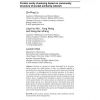Free Online Productivity Tools
i2Speak
i2Symbol
i2OCR
iTex2Img
iWeb2Print
iWeb2Shot
i2Type
iPdf2Split
iPdf2Merge
i2Bopomofo
i2Arabic
i2Style
i2Image
i2PDF
iLatex2Rtf
Sci2ools
100
Voted
IJBRA
2008
2008
Protein cavity clustering based on community structure of pocket similarity network
: Functions of a protein are mainly determined by its structure. Surface cavities, also called pockets or clefts, are ordinarily regarded as potentially active sites where the protein carries out the functions. Clustering these pockets is a challenging task in structural genomics. In this paper, we introduce pocket similarity network which possesses the feature of community structure to systematically describe structural similarity among pockets, then a straightforward classification scheme is developed based on this special feature. The surface pockets are clustered into structurally similar pocket groups via a hierarchical process. We identify these small pocket groups as structural templates which represent similar functions in diverse proteins. The experimental results show that our clustering method is effective, and the identified pocket groups are biologically meaningful in terms of their functional features.
IJBRA 2008 | Pocket | Pocket Groups | Proteins |
Related Content
| Added | 12 Dec 2010 |
| Updated | 12 Dec 2010 |
| Type | Journal |
| Year | 2008 |
| Where | IJBRA |
| Authors | Zhi-Ping Liu, Ling-Yun Wu, Yong Wang, Xiang-Sun Zhang, Luonan Chen |
Comments (0)

